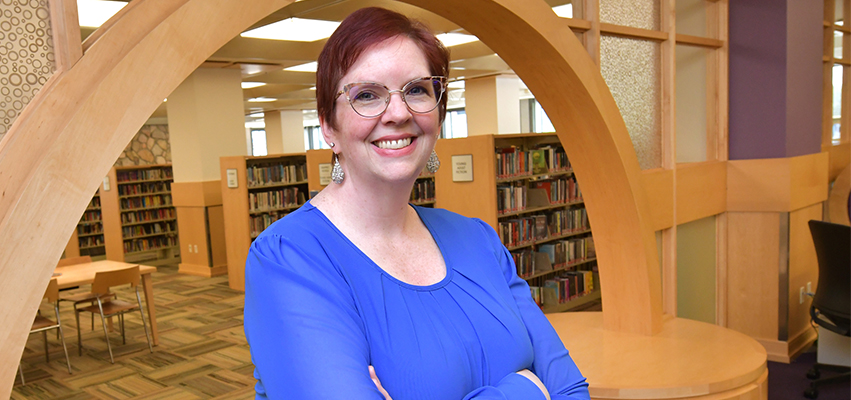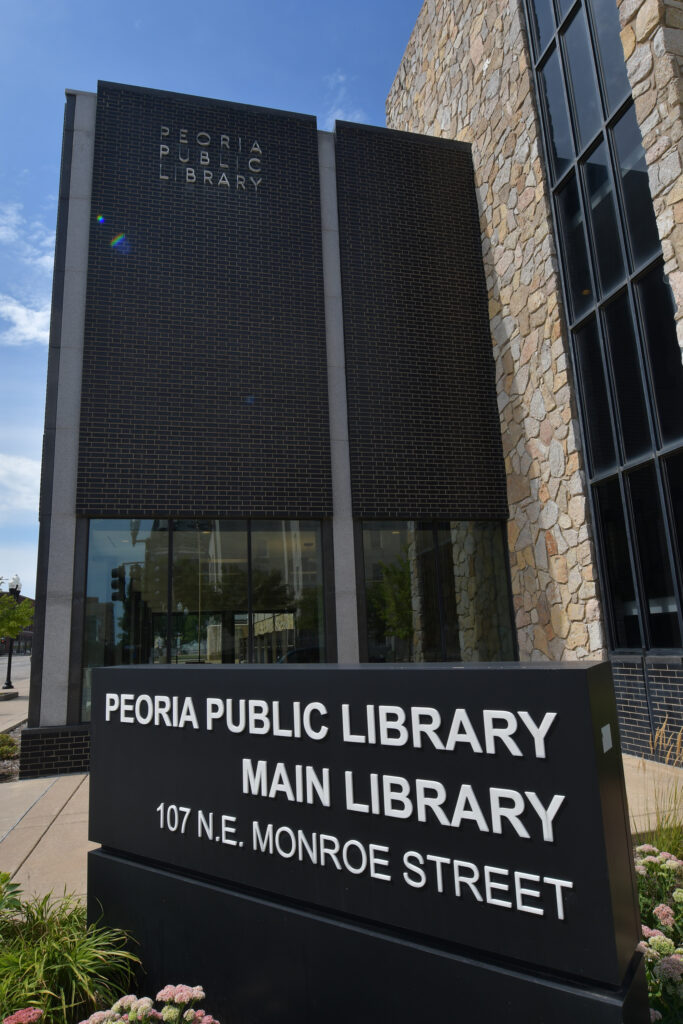Big shoes to fill. We’ve all heard that. But for librarians, is it big bookshelves to fill?
Veronica De Fazio is Peoria Public Library’s new deputy director, succeeding Roberta Koscielski, the 2020 Illinois Librarian of the Year. Koscielski built strong local connections over her 38-year career at Peoria Public Library, but De Fazio brings fresh eyes. As the past president of the Illinois Library Association, the third largest library association in the country, she also has connections to libraries across the state.
De Fazio has more than 20 years of experience at medium and large libraries in Illinois, including public libraries in Plainfield and Des Plaines. She recently responded to a few questions so we can all get to know her better.
Jennifer Davis (JD): We know you haven’t been here long, but give us your first impression of Peoria.
Veronica De Fazio (VDF): I have really been pleasantly surprised by Peoria. It has so many of the amenities of a bigger city, but maintains that small town, community feel. Peorians are passionate about the place they call home, and rightfully so. From the rich history of the whiskey barons to the cultural arts and entertainment of today, Peoria really does have something for everyone.
JD: What made you decide to become a librarian?
VDF: Growing up in a small town in Michigan, I was a painfully shy, introverted child. The public library was my refuge, a place where I truly felt like I could be myself. The staff at the library knew my name, never judged me for checking out armloads of books, and always made me feel seen and respected. What I had to say was important to them. When I was trying to figure out what to do with my life, I realized that I wanted to make kids and teens feel the way that those folks made me feel, so I became a children’s librarian. Even though I don’t get to work directly with the public that often anymore, when I do get work with the youth of our community, those are the most rewarding times of my day.
JD: Libraries are in the news nationwide as the number of book challenges have more than tripled in the last couple of years. Peoria Public Library has not had the same experience to date. Can you speak to that?
VDF: Our residents have a tremendous amount of love for the library. They see every day that we are here for them, both in our buildings and out in the community. And as such, they respect us for carrying materials that not only reflect a wide variety of viewpoints, but also reflect the incredibly diverse users that we serve.
JD: It’s often said that libraries are ever evolving to meet the needs of their communities. Can you talk about some of the hot trends right now?
VDF: Offering current technology to our users so that they don’t have to incur the cost continues to be something that libraries are focusing on. Whether it’s providing digital media labs, creating maker spaces filled with crafting and building tools, lending laptops, or circulating wi-fi hot spots, libraries are doing their best to provide access to these items at little to no cost to the user.
Pre-pandemic libraries (school, academic, and public) were working to evolve their spaces from quiet buildings designed for quiet work into collaborative spaces and community gathering places. As we’ve emerged from the more isolating COVID times, we’re seeing users return to the library for these reasons and more. The pandemic shifted the work model, and with so many people now working remotely, they are turning once again to libraries to be the place that gets them out of their homes and provides them with reliable connectivity and space to conduct their business.
In public libraries, early literacy areas continue to be incorporated into the children’s departments, providing spaces for children to play and explore their boundless imaginations — elements that are critical to the skills needed for emerging readers.
JD: What do you envision libraries in general doing in five or 10 years?
VDF: In the coming years, libraries will continue to embrace new and emerging technologies and develop creative ways of providing those technologies to their users. They will also expand the idea of the library as a community space. Libraries currently offer services such as onsite social workers, educational and cultural programming, and meeting spaces. In the future they will continue filling needs as they arise in their communities.
One of the amazing things about libraries is that they are ever evolving. When the internet arrived, they said that libraries were no longer going to be needed. When eBooks came on the scene, they said libraries were going to become obsolete. When a global pandemic hit, they said libraries weren’t essential, even as we boosted our internet signals, provided virtual programs to keep children engaged, and helped members of our communities gain access to the information they needed to make it through those scary times. But here we are.
There is no way of telling what will come along in the next five to 10 years, but no matter the circumstances, you can be sure that libraries will rise to the challenge and continue to find new and innovative ways to be relevant to their communities.
JD: What are the biggest challenges for libraries? In particular, can you tell yet what the biggest challenge for Peoria Public Library is?
VDF: One of our greatest strengths is also one of our biggest challenges. Over the past decade, each of our branches has worked very hard to learn the needs and wants of the area in which it resides and strives to provide them with the best service possible. I think in that regard, we’ve been very successful. Where that becomes a challenge is that while each branch has its own identity, the overarching Peoria Public Library does not. That is something that we hope to work on going forward. We want our users to think fondly not just about the branch where they go most often, but the library as a whole. We want to create services and programs that encourage our users to visit all of our buildings and take advantage of everything that we have to offer.






